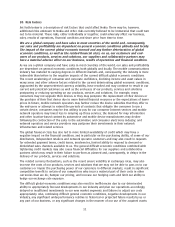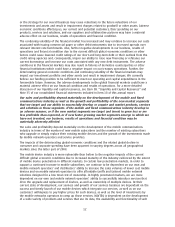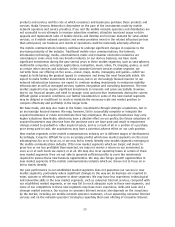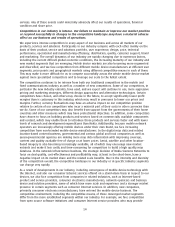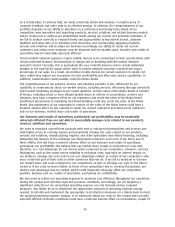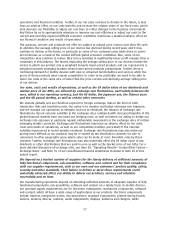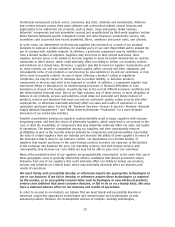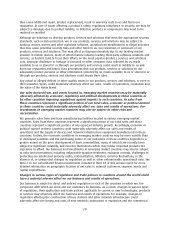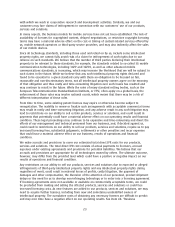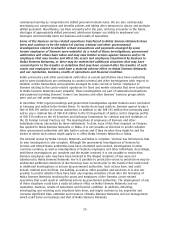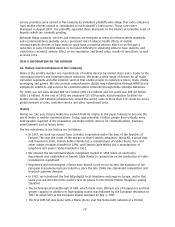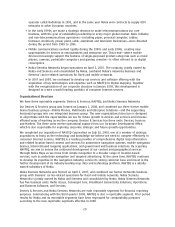Nokia 2008 Annual Report Download - page 22
Download and view the complete annual report
Please find page 22 of the 2008 Nokia annual report below. You can navigate through the pages in the report by either clicking on the pages listed below, or by using the keyword search tool below to find specific information within the annual report.launch and ultimate commercial success of these networks. Export control, tariffs or other fees or
levies imposed on our products, environmental, product safety and security and other regulations that
adversely affect the export, import, pricing or costs of our products, services and solutions, as well as
new services related to our products, could also adversely affect our sales and results of operations.
For example, copyright collecting societies in several member states of the European Union claim that
due to their capability to play and store copyrighted content, mobile devices should be subject to
similar copyright levies that are charged for products such as compact disc, digital video disc or
digital audio players. Also, the European Commission is considering measures that would require the
member states of the European Union to levy import duties for highend mobile devices and their
components which, if eventually taken, could potentially result in similar countermeasures by the
other countries outside the European Union. Any new or increased levies and duties could result in
costs which we may not be able to pass on to our customers or higher prices for our products,
services and solutions which may impair their demand.
The impact of changes in or uncertainties related to regulation and trade policies could affect our
business and results of operations adversely even though the specific regulations do not always
directly apply to us or our products, services and solutions. In addition to changes in regulation and
trade policies, our business may be adversely affected by local business culture and general practices
in some regions that are contrary to our code of conduct. Further, our business and results of
operations may be adversely affected by regulation and trade policies favoring the local industry
participants as well as other measures with potentially protectionist objectives which the host
governments in different countries may take, particularly in response to the current difficult global
economic conditions.
See Item 4B. “Business Overview—Government Regulation—Devices & Services, NAVTEQ and Nokia
Siemens Networks” for a more discussion about the impact of various regulations.
We are developing a number of new products, services and solutions together with other
companies. If any of these companies were to fail to perform as planned, we may not be able
to bring our products, services and solutions to market successfully or in a timely way and
this could have a material adverse effect on our sales and results of operations.
We invite the providers of technology, components or software to work with us to develop
technologies or new products, services and solutions. These arrangements involve the commitment by
each company of various resources, including technology, research and development efforts, and
personnel. Our ability to collaborate successfully is increasingly important in our new markets
segments, such as consumer Internet services and with the open source software communities.
Although the objective of the collaborative arrangements is a mutually beneficial outcome for each
party, our ability to introduce new products, services and solutions that meet our and our customers’
quality, safety, security and other standards successfully and on schedule could be hampered if, for
example, any of the following risks were to materialize: we fail to choose the right companies as our
partners or we are unable to collaborate effectively to reach the targets set for the collaboration; the
arrangements with the companies that work with us do not develop as expected; the technologies
provided by the companies that work with us are not sufficiently protected or infringe third parties’
intellectual property rights in a way that we cannot foresee or prevent; the technologies, products,
services or solutions supplied by the companies that work with us do not meet the required quality,
safety, security and other standards or customer needs; our own quality controls fail; or the financial
condition of our collaborative partners deteriorates which may result in insolvency or closure of the
business of such partners. Further, the current difficult global economic conditions and the related
financial crisis may decrease the number of collaborative partners and limit the ability of the
remaining collaborative partners to invest in their technologies, products, services or solutions. Any of
these events could materially adversely affect our sales and results of operations.
21


